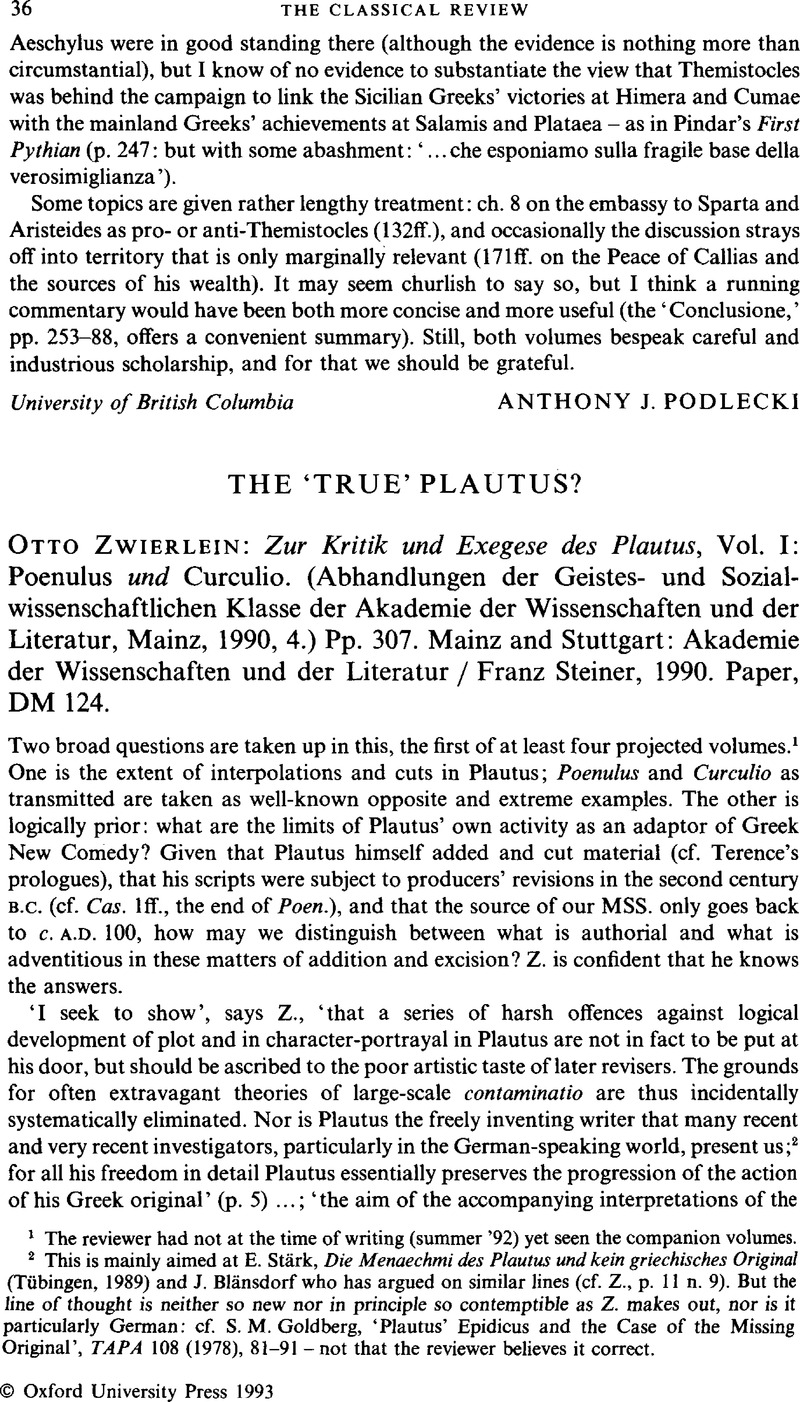Article contents
The ‘True’ Plautus? - Otto Zwierlein: Zur Kritik und Exegese des Plautus, Vol. I: Poenulus und Curculio. (Abhandlungen der Geistes– und Sozialwissenschaftlichen Klasse der Akademie der Wissenschaften und der Literatur, Mainz, 1990, 4.) Pp. 307. Mainz and Stuttgart: Akademie der Wissenschaften und der Literatur / Franz Steiner, 1990. Paper, DM 124.
Published online by Cambridge University Press: 16 February 2009
Abstract

- Type
- Reviews
- Information
- Copyright
- Copyright © The Classical Association 1993
References
1 The reviewer had not at the time of writing (summer '92) yet seen the companion volumes.
2 This is mainly aimed at Stärk, E., Die Menaechmi des Plautus und kein griechisches Original (Tübingen, 1989) and J. Blänsdorf who has argued on similar lines (cf. Z., p. 11 n. 9). But the line of thought is neither so new nor in principle so contemptible as Z. makes out, nor is it particularly German: cf. S. M. Goldberg, ‘Plautus’ Epidicus and the Case of the Missing Original', TAPA 108 (1978), 81–91 – not that the reviewer believes it correct.Google Scholar
3 Poen. 121–3/124–7, 218/217 + 219, 303–4, 419, 457ab, 567–75, 923–9, 930–49 but not 950–60, 1042–3, 1169–73, 1322–37, 1342–71, 1385–6.
4 Z. (p. 78) elicits the sequence 1315–21, 1338–41, 1372–84, 1387–90 as the authentic Plautine finale, naturally without being able to account for the complex dislocation thus assumed. Observing rightly that this combination disposes of the entrance–formulae sed eccum uideo…, auscultabo…, quis hic loquitur…, material readily available in the context, and that the result has a Menandrian naturalism, Z. deduces, not that this particular combination has no chance whatever of being authentic, but instead coolly prescribes that ‘in future one will assume a much greater degree of agreement between Menander and (the true) Plautus (in this matter of technique) and direct the blame for corruption of Menander's lifelike stagecraft (in the matter of continuity and the signalling of cues) not at Plautus, but at his revisers’. Yes, and no doubt the same incompetent vandals made a point of doing over Terence's entrances as well while they were at it? For Terence is just as un–Menandrian in this respect as the scripts of Plautus.
5 Poen. 79–82, 91–2, 99–100, 118–20, 176, 214, 232, 245a, 339–42, 345–6, 372, 375, 385, 390, 393, 551, 560, 725, 732–4, 738–40, 743–5, 782–4, 801–5, 982–4, 1020, 1084, 1091–2, 1108, 1125–6, 1162–5, 1215, 1278–9, 1284, 1288–97, 1398–1401, 1406.
6 Cur. 143–4, 194, 206–7, 291, 310–18, 344, 367–8, 382–3, 455–61, 475, 483, 485, 515, 522–4, 545, 547–8, 622, 680, 712–13, 720.
7 Götz, G., ‘De compositione Poenuli plautinae commentariolum’, Index scholarum hibernarum habendarum (Jena, 1883/1884), pp. 3–8 (not mentioned by Z.) argued that the revision is meant for a version of the play in which IV 1–2 preceded III 1–6, securing a speciously greater degree of dramatic unity. There is something to be said for this, but that this was actually the Plautine arrangement (so Götz) is ruled out by the programmatic remarks at 615–18, which clearly foreshadow IV.2 as transmitted.Google Scholar
8 Brachmann, W., ‘De Bacchidum plautinae retractatione scaenica capita V’, Leipziger Studien zur Classischen Philologie 3 (1880), 57 (not mentioned by Z.).Google Scholar
9 After the allusion (Z., p. 35 n. 63) to CHCL ii (1982), p. 107 the reviewer expected further enlightened comment at Z., pp. 194–7 on the reading of Poen. 1107–8 proposed at CHCL ii (1982), p. 103 n. 1, and on the whole argument ibid. pp. 99–103; but in vain.
- 1
- Cited by




